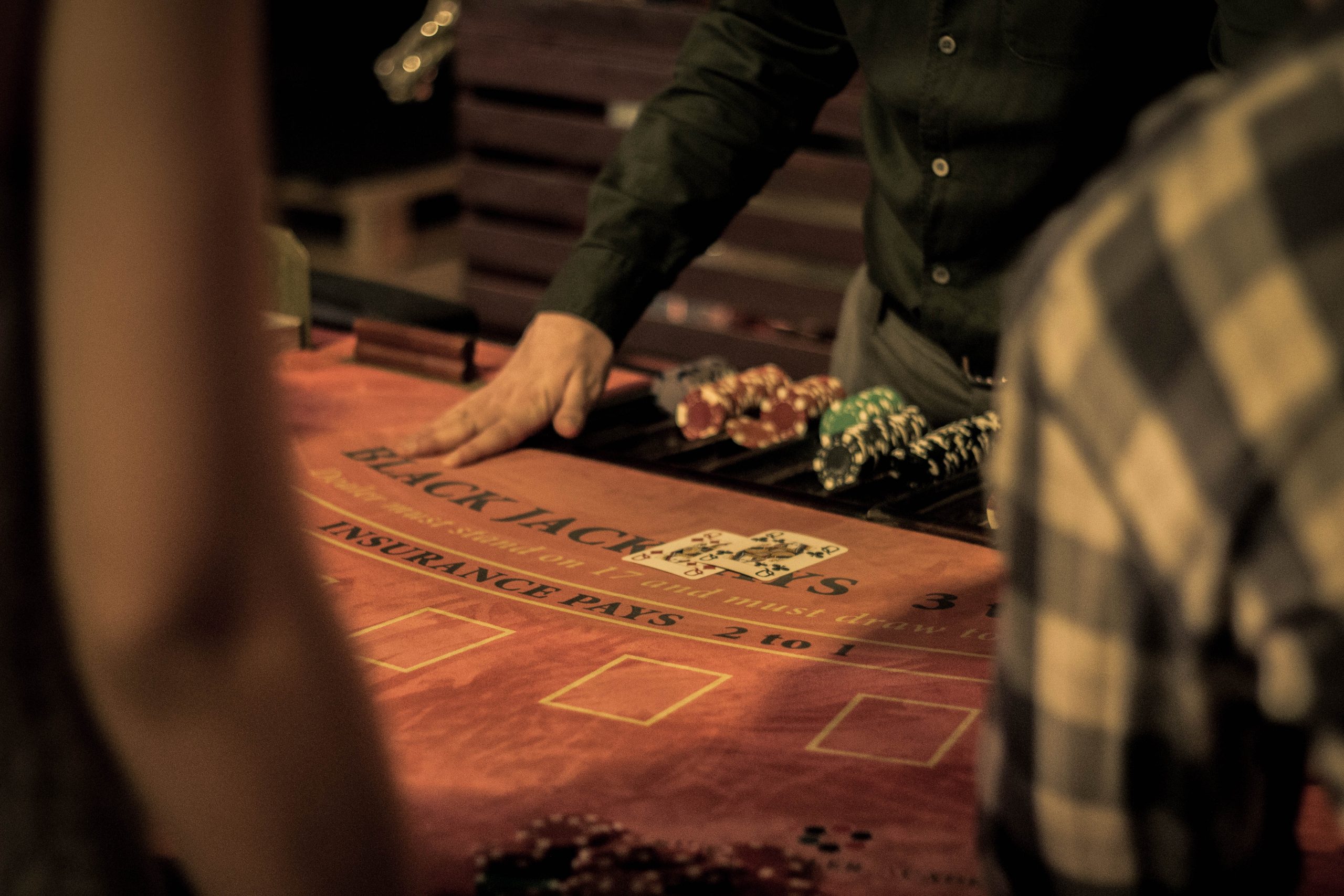Goal of the Game:
Your main aim is to beat the card dealer.
How can you beat the dealer?
- Have cards that total higher than the dealer’s cards.
- The dealer has cards totaling over 21.
- You get 21 with your first two cards, and the dealer doesn’t.
How can you lose?
- Your cards total more than 21.
- The dealer has cards totaling higher than yours by the end.
Remember: In this game, you’re playing against the dealer, not the other players.
Playing the Game
Card Values:
- Numbers 2-10 are worth their face value.
- Jacks, Queens, and Kings count as 10.
- Aces can be 1 or 11, whichever benefits you more.
The Blackjack Table:
It’s shaped like a half-circle with places for players. The dealer stands on one side, and the players sit opposite. There can be many places for players, but usually, there are 7.
Steps to Play Blackjack:
- Buy Chips:
You need chips to play. Go to the table, put your money on it (don’t hand it directly to the dealer), and they’ll exchange it for chips. - Place Your Bet:
Put your chips in the betting circle in front of you. Tables will have signs showing the minimum and maximum bets. - Get Your Cards:
The dealer gives everyone two cards. Players’ cards are face up, but the dealer has one card face up and one down. - Decide Your Move:
- Stand: Happy with your cards? Wave your hand, and it’s the next player’s turn.
- Hit: Want another card? Tap the table.
- Double Down: Double your bet for just one more card.
- Split: Have a pair? Split them into two separate hands and bet for each.
- Surrender: Don’t like your cards? Get half your bet back.
- Dealer’s Turn:
After all players are done, the dealer reveals their hidden card. They must keep taking cards until they have 17 or more. Sometimes, if they have an Ace and a 6 (a “soft 17”), they might take another card. - Who Wins?:
- If the dealer goes over 21, players still in the game win.
- If the dealer has a higher total than you, you lose your bet.
- If you have a higher total, you win the same amount as your bet.
- If both have the same total, it’s a tie, and you don’t win or lose.
And that’s it! Once the round ends, you can play again.
Interested in Elevating Your Blackjack Skills?
Dive into our comprehensive Blackjack Strategy Guide below!
Blackjack Strategy Guide
Special Situations in Blackjack
- Insurance/Even Money: When the dealer’s up-card is an Ace, players are offered a side bet known as insurance. If you have a Blackjack, it’s called even money. This is essentially a wager predicting that the dealer’s hole card is a ten. Basic strategy suggests avoiding insurance and even money unless you’re a seasoned card counter. Always remember, even money is merely another term for insurance, and if you opt for it, your Blackjack payout will deviate from the standard 3 to 2 rate.
- Non-Insurable Dealer Blackjack: Sometimes, the dealer might have a Blackjack without offering insurance. If their up-card is a ten, they’ll instantly reveal their hole card. An Ace would mean they have a Blackjack, leading to most bets on the table being collected, except player Blackjacks which will push. Insurance is only presented when the dealer’s up-card is an Ace.
- Dead Hand: If all players bust before the dealer acts, the dealer will reveal their hole card for surveillance purposes and move on to the next hand.
- Side Bets: Over recent years, various side bets have emerged in Blackjack. Although insurance is the most widely recognized side bet, numerous others exist. These bets can range from predicting your initial hand composition to matching the dealer’s cards. However, it’s essential to remember that these bets typically favor the house significantly. Instead of getting sidetracked by them, it’s wiser to learn card counting techniques.
Read more: What is Rummy in Blackjack
Blackjack Rule Variations
- Doubling After Splitting (DAS): Some casinos allow players to double down after splitting their cards.
- Re-Splitting Aces (RSA): At specific casinos, after initially splitting aces, if you receive another ace, it’s permissible to split again. However, after splitting, only one additional card is typically allowed.
- Early Surrender: An extinct rule where players could surrender before the dealer checked for Blackjack. This rule was highly advantageous to players, leading to its discontinuation.
- 6 to 5 Blackjacks: Some casinos have altered the traditional 3 to 2 Blackjack payout to a less favorable 6 to 5, increasing the house advantage.
- Continuous Shuffling Machines (CSM): Certain casinos use these machines to continually shuffle cards, making card counting virtually impossible.
- Single vs. Multi-deck Games: The number of decks used can influence the house edge, but other rules often offset this.
- Deck/Shoe Penetration (PEN): Refers to how deep into the shoe the dealer goes before shuffling. This aspect is crucial for card counters.
Read more: Mastering Blackjack: Unlock the Winning Edge
Beware of Imitations!

Several games are dressed up to mimic Blackjack due to its immense popularity. However, they often tilt the odds heavily in the casino’s favor. Some of these include:
- Super Fun 21: Although it offers several enticing rules, its payout for Blackjacks is even money, increasing the house edge substantially.
- Spanish 21: Despite its similarity to standard Blackjack and inclusion of favorable rules, all ten cards are removed from the deck, shifting the odds.
- Free Bet Blackjack: Even though the casino covers your splits and double downs, a dealer total of 22 will push all bets, increasing the house advantage.
- Blackjack Switch: You can exchange top cards between two hands, but Blackjacks only pay even money, and a dealer 22 pushes all bets.
Always ensure you’re playing genuine Blackjack, familiarize yourself with the specific rules of the table, and avoid games that merely capitalize on Blackjack’s reputation without offering fair gameplay.

